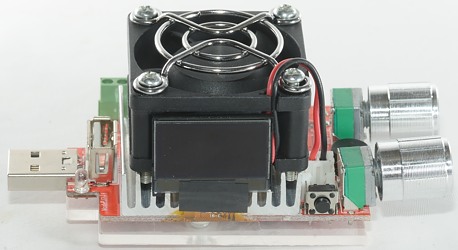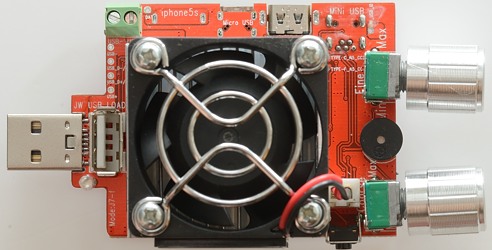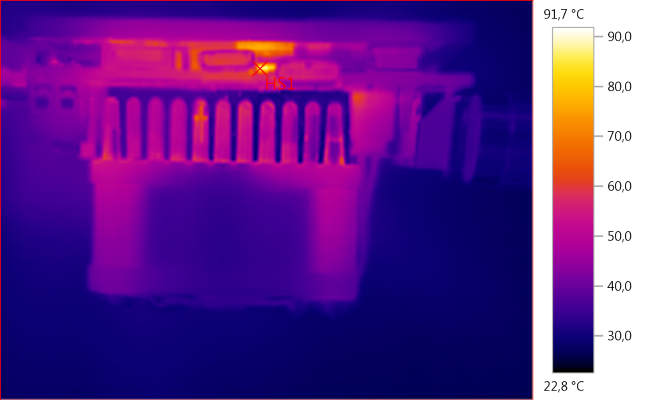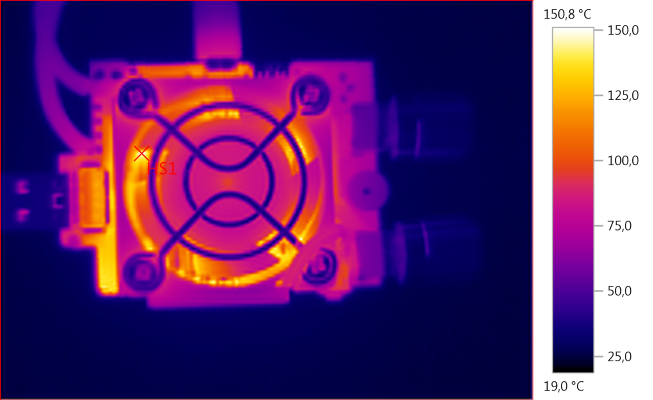Electronic load 35W 3A with OLed display J7-f

Official specifications:
- Industrial discharge load USB tester
- 2016 new upgrade electronic load King
- Intelligent temperature control Double adjustment design
- USB Dual Adjustment accuracy Electronic Load discharger
- Industrial grade long life 35W power continuous discharge
- Voltage:3-21V Current:0-3A
- Real-time monitoring
- Voltage display Current display capacity display Electrical voltage display Power display Timing display
- Power Down Data Retention Charging time protection
- Support Qualcomm QC2.0 compatible QC3.0 fast charging voltage test
- One screen multi group data Display
- Measurement through kill
I bought it from ebay dealer kiss_buy

It arrived in a small box without any documentation or accessories.


The only paper included was the above notice.

On this side it has many different input connectors: Mini-usb, micro-usb, usb-C, Apple, screw terminals, they are all in parallel.

This side is the usb meter with a Oled display and a single button.


One end has usb input and usb output, the other end has coarse and fine control.
The current regulation is a bit slow, making it difficult to set a precise current, but with the low precision of the load it is not a problem.

The circuit board is fairly well labeled and there are a few interesting solder points on it.

The bottom is protected with a piece of plastic, due to the screws it is not a flat surface.

A closer look at the different connectors.

The bottom without plastic.



The display looks and function like a typical usb meter, it has one button.
Measurement
- The usb connector is reversible, this way it is always possible to connect the most convenient way.
- Minimum setting about 30mA at 5V and 50mA at 21V when fan is off (Display shows 0)
- Minimum setting is 0.18A when fan is on.
- Maximum setting is slightly above 3.1A.
- Coarse control regulates about a 3A range.
- Fine control regulates about a 0.16A range.
- Fan on/off is temperature controlled, it has no speed control.
- At 12V and 3.00A the current was stable within 2.7%
- At 12V and 1.00A the current was stable within 2.4%
- Will remember settings after a power cycle.
- Meter is 0.02V wrong around 5V and 0.2V wrong at 20V
- Meter is about 0.1A wrong, it varies with temperature.
- The circuits idle current consumption is not included in the meter reading.
- The buzzer will sound when power is applied and when current/voltage is out of range.

The current varies with voltage. The load has a power limiter, this limiter will turn the load off for a short time if the power is too high as can be seen on the yellow, magenta and white curve.
Minimum voltage is about 4 volt.

At low current it will vary significantly with voltage.

I did two load tests, both at 11V, but at different currents.
At the 3A the build-in meter says: 59:01min, 2.941Ah and 31.573Wh
My power supply has delivered: 2,98546Ah, 32,840758Wh over 60:01min
At the 1A the build-in meter says: 59:01min, 0.918Ah and 10.051Wh
My power supply has delivered: 0,94121Ah, 10,353675Wh over 60:01min
Some reason for differences:
Meter on load need a few seconds to startup, but not one minute!
Some power is lost in the cable and connections.
The load do not include its own idle consumption in the calculations.
Loads current calibration was a bit low, it showed 2.94A and 0.94A (Values jumped about 0.02A up and down).

The precision is not very good, some of it can be calibrated out.

M1: 62,8°C, M2: 52,8°C, M3: 54,3°C, M4: 47,6°C, HS1: 79,1°C

M1: 54,8°C, M2: 39,7°C, HS1: 78,5°C

M1: 61,1°C, HS1: 63,3°C
The plastic prevents me from getting the real temperatures on the circuit board.

HS1: 98,2°C

HS1: 91,7°C
Here I tried to get a direct check of the transistor.

HS1: 150,8°C
The fan stopped working during my tests and the load got very hot.
Conclusion
This load has many input connectors, making it easy to use for just about any usb power device and also for some other stuff, but the fairly low precision and annoying current setting spoils it. That the fan quit working during my test is also a bad sign.
Notes
To test QuickChargers it is possible to use the QC2-3-MTK-PE Trigger J7-t with this load. For QC it can be used in the output connector and will not add any resistance to the circuit, with MTK-PE it must be used on the input and will add resistance.
























